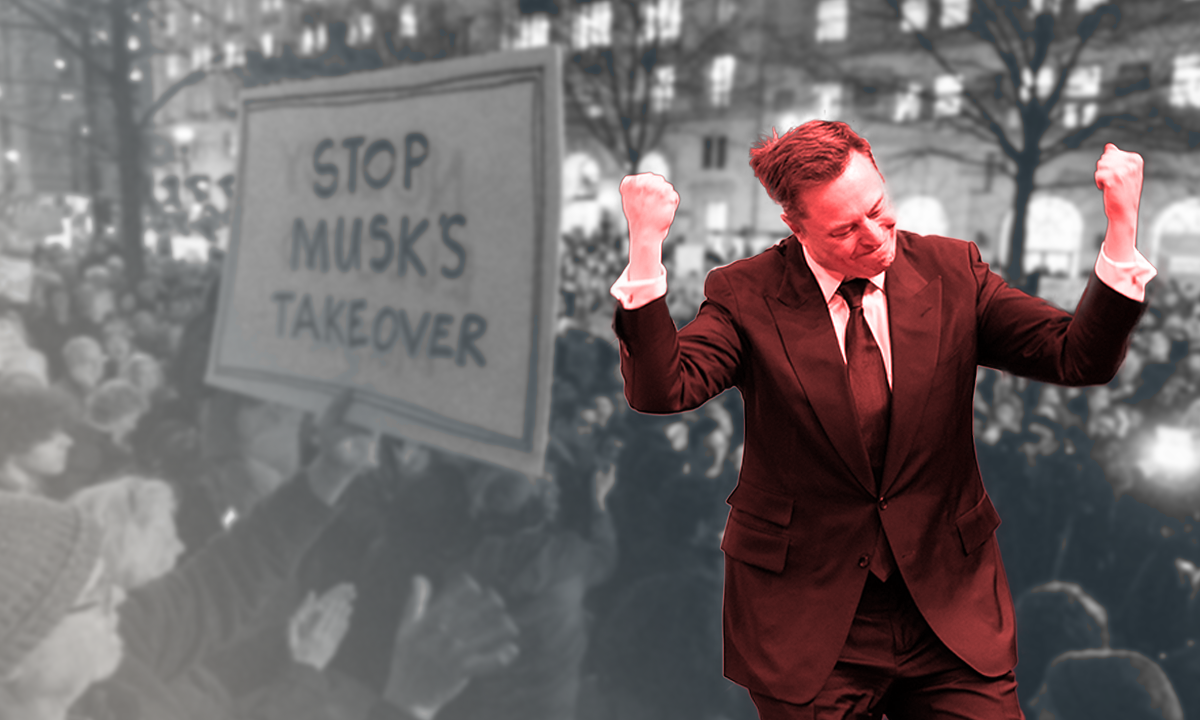The Department of Government Exploitation
The Trump-Musk assault on the federal workforce aims to complete the neoliberal project of privatizing every aspect of government. If Elon Musk is serious about saving money, he should go after private contractors. (Graphic by Truthdig. Images sourced via AP Photo)
If Elon Musk is serious about saving money, he should go after private contractors. (Graphic by Truthdig. Images sourced via AP Photo)
The basic premise of Elon Musk’s Department of Government Efficiency — that the federal government loses untold billions of dollars each year due to waste, fraud and systemic inefficiencies — is mostly true. According to the Government Accountability Office, the federal government made roughly $236 billion in “improper payments” during the fiscal year of 2023. This includes everything from overpayments to inaccurate recordkeeping to outright fraud. An even bigger source of fiscal drain comes from what the government doesn’t collect in revenue each year due to tax avoidance: In 2022, the IRS estimated a tax gap of more than $600 billion.
Last month, David Dayen exhaustively detailed in the American Prospect how federal spending could be dramatically curtailed — perhaps by as much as Musk’s proposed $2 trillion target — by addressing these and other operational failures in the bureaucracy. Importantly, this could be done without gutting agencies or defunding popular programs and services that countless Americans depend on. “The key lies in knowing where to look,” Dayen writes, pointing to “profit-hungry contractors, privatized boondoggles, systemic overpayments, and a mountain of tax avoidance.”
Achieving these savings would require not only a more efficient government, but a more effective one. Yet in the month since Musk and his allies launched their “efficiency” crusade inside the executive branch, it has become clear that they have little genuine interest in making the government more efficient, let alone more effective. On the contrary, it appears the goal is to drastically curb or eliminate as many government functions as possible while outsourcing and privatizing the rest.
If the real aim is to improve the government and eliminate waste, then the last thing that Musk and his allies should be doing right now is haphazardly firing as many federal employees as possible. Though the billionaire has promoted large-scale reductions in the workforce as a major source of potential savings, it is important to recognize just how little the federal workforce costs relative to the value it provides to the American public. In 2022, the entire payroll for the federal workforce was roughly $271 billion, which represents a little over 4% of total annual spending. This is not much more than all of the annual improper payments, and it is significantly less than the $400 billion it will cost annually if the Trump tax cuts are extended this year.
The federal workforce is actually slightly smaller than it was 50 years ago.
It is also far less than what the federal government spends on outsourcing and contracting with private companies. To put this in perspective, the federal government doles out nearly three times more on contracting each year than it does on the entire federal workforce, with well over half of that spending — approximately $456 billion — coming from the notoriously opaque Department of Defense.
The dirty little secret that conservative critics of the “administrative state” almost always fail to mention is that the federal workforce has barely changed in size since the 1960s, even as the U.S. population has increased by almost two-thirds. In absolute numbers, the federal workforce is actually slightly smaller than it was 50 years ago. While federal employees represented more than 4% of all workers in America in 1960, that number has since dropped to around 1.4%. During this same period, federal spending has grown exponentially thanks to an aging population and other factors. “The inconvenient truth,” wrote University of Pennsylvania political scientist John DiIulio in his provocative 2014 book “Bring Back the Bureaucrats,” “is that the federal workforce has shrunk, not only relative to how much money rushes through it, but also relative to the number and complexity of the tasks that it is supposed to execute … and the proxies that it is supposed to manage and monitor.”
It is the number of “proxies” — namely, private contractors — that has vastly increased over the last several decades. The push toward outsourcing government operations to private (and primarily for-profit) contractors picked up steam in the closing decades of the 20th century, when politicians were eager to prove their opposition to “big government.” In announcing his “Reinventing Government” initiative at the start of his presidency in 1993, Bill Clinton declared that its goal was to “make the entire federal government less expensive and more efficient,” in part by reducing the size of the federal workforce by more than 250,000 positions and slashing regulations (sound familiar?) The Clinton administration ultimately did reduce the size of the federal workforce, but largely by outsourcing a growing number of services and government functions to the private sector.
That trend accelerated under George W. Bush, whose administration famously pushed for more privatization and outsourcing while calling for the elimination of up to 850,000 federal jobs. Just one day before the attacks on Sept. 11, Bush’s secretary of defense, Donald Rumsfeld, made a remarkable speech that could have been delivered by Elon Musk today. While declaring the Pentagon bureaucracy “the enemy,” the former pharmaceutical CEO called on the department to “employ the tools of modern business” and find as many functions as possible that could be “performed better and more cheaply through commercial outsourcing.” Between 2000 and 2005, the fastest growing part of the discretionary budget came from contracting for goods and services, most of which came from DOD (filling the coffers of notorious contractors like Blackwater and Halliburton).
Outsourcing government functions was a simple solution for politicians who wanted to proclaim “the era of big government” over, without having to actually eliminate all of the critical functions and services that people expect from government. DiIulio partly sees the rise of the contracting state — or what he calls “Leviathan by Proxy” — as the product of America’s historical ambivalence toward government. “Americans do indeed hate ‘big government,’ but they also love, love, love federal government goods, services, and benefits,” he observed. In the end, contracting didn’t slow the growth of spending or reduce the actual size of government, but instead created a “grotesque form of big government that guarantees bad government.”
It also created a much more expensive government. Though privatization and outsourcing were pitched as cost-saving and efficiency-boosting strategies, in practice they’ve often had the opposite result. One report from the Project on Government Oversight found that service contractors are paid by the government at rates “far exceeding the cost of employing federal employees to perform comparable functions.” These high costs offer many potential savings opportunities, as Dayen and others have detailed. But, just as reducing improper payments or cracking down on tax avoidance by the wealthiest Americans will require more career civil servants at understaffed agencies, so too will curbing the contracting state. It was for this very reason that the politically conservative DiIulio called for expanding the federal workforce by 1 million employees back in 2014. “If we want to pump the brakes on big government’s expansion while improving its performance, then we must start by pruning the system’s proxies while increasing the federal workforce,” he said.
Of course, Musk and Trump are currently doing the opposite. Last week, with the world’s richest man (and his toddler) by his side, the president signed an executive order instructing department and agency heads to undertake plans for “large-scale reductions,” with the goal of dramatically shrinking the federal workforce. The new order will require agencies to hire only one new employee for every four who leave, which will severely hamper their ability to carry out their mission. A few days after the signing, the administration officially began unilaterally firing probationary employees across the government.
It is the number of “proxies” — namely, private contractors — that has vastly increased over the last several decades.
This dramatic reduction in numbers will bring little in direct savings, nor will it improve government performance. Instead, it will create a further hollowed out government that is even more dependent on private contractors to carry out basic government operations.
This assault on the federal workforce dovetails with the broader goal of privatization. Trump has already signed executive orders pushing for more privatization in education and prisons, and has floated privatizing other government services, such as the Postal Service and air traffic controllers. The new administration will “look for every opportunity to drive outsourcing and privatization,” Donald Cohen, co-author of “The Privatization of Everything,” told me. This includes putting up government assets for sale. According to Wired, the General Service Administration, which oversees the management of federal buildings, has been ordered to sell off more than 500 of the 1,500 federal buildings, which house government agencies and offices for U.S. senators. The GSA will take “advantage of a stronger private/government partnership in managing the workforce of the future,” a press release read last week.
For Musk, privatization goes hand-in-hand with his concept of efficiency. The only way to truly improve efficiency, according to the billionaire, is by pushing as many public sector employees as possible into “higher productivity jobs in the private sector,” as one of the OPM’s letters to federal employees put it. One major reason Musk sees the private sector as a more “efficient operating system” is because of how much easier it is for the boss to exploit his employees. Unlike private sector workers, who can be easily dismissed without cause or due process, federal employees have civil service protections that shield them from the capricious whims of their vindictive boss. Public sector employees are also far more unionized: according to the latest data from the Bureau of Labor Statistics, more than 32% of public sector employees in America are union members, compared to less than 6% in the private sector (down from 33% in the mid-20th century). As arguably the world’s most notorious union buster, few things frustrate Musk more than workers demanding fair contracts through collective bargaining. Hence the assault on the civil service.
In the end, what Musk calls “efficiency” is what others call exploitation. Cohen draws a useful distinction between what he calls “smart efficiency,” which involves optimizing processes, and “extractive efficiency,” which prioritizes maximizing financial gains. The pursuit of efficiency boils down to achieving more with less, yet there are only so many ways to accomplish this goal. “You can pay people less, you can have fewer workers, you can have crappier or lower quality supplies and equipment. There’s not much more you can do to be more efficient,” he said. Private companies will do whatever they can to extract more value out of workers, customers and — in the case of contractors — the government.
This is plainly evident in Medicare Advantage, which was created two decades ago as a private-sector alternative to traditional Medicare on the premise that private companies would find innovative ways to improve care and lower costs. As with outsourcing, something very different has occurred. A 2022 exposé from the New York Times revealed that insurance companies have milked the program for profits and developed “elaborate systems to make their patients appear as sick as possible,” resulting in billions in overpayments each year. Last year, a report from Congress’s advisory board on Medicare, MedPAC, estimated that Medicare pays 22% more for Advantage enrollees than it does for those on traditional Medicare, translating to roughly $83 billion in higher costs for just 2024. Not only does traditional Medicare have much lower administrative costs than its privatized alternative, but delivers better and more reliable care for seniors.
If this is private sector efficiency, then we can expect the government to become a lot more inefficient and wasteful in the months ahead. We can also expect private contractors like SpaceX and Palantir to reap a major windfall in taxpayer dollars.
Your support is crucial...As we navigate an uncertain 2025, with a new administration questioning press freedoms, the risks are clear: our ability to report freely is under threat.
Your tax-deductible donation enables us to dig deeper, delivering fearless investigative reporting and analysis that exposes the reality beneath the headlines — without compromise.
Now is the time to take action. Stand with our courageous journalists. Donate today to protect a free press, uphold democracy and uncover the stories that need to be told.






You need to be a supporter to comment.
There are currently no responses to this article.
Be the first to respond.